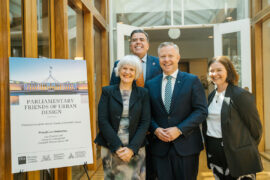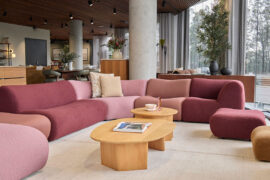With a recent book on natural Australian gardens, we spoke with the Victorian landscape designer on what it means to take a truly holistic approach to the environment.

January 8th, 2024
Phillip Withers, director of the eponymous landscape architecture and horticulture studio, has had something of an unorthodox path into the field. Withers initially studied fashion design and then screen printing but, after spending time travelling and working with friends in garden maintenance in rural Victoria, he discovered his future course. “At that time, I just found this connection to the landscape,” he says with clarity.
It’s a trajectory that has led through studies in landscape design and sustainability all the way to becoming one of Australia’s pre-eminent practitioners and, more recently, having a book released on his work. Naturescapes, published this year and authored by Withers and AB Bishop, provides a guide for creating a natural Australian garden. With photography by Amelia Stanwix, it’s a beautiful and inspiring book, as well as being totally accessible to the casual, residentially focused reader.

Indeed, one of the defining features of Phillip Withers’ work is an ability to engage with landscape in its full depth and richness while also making room for these concerns at a domestic, residential scale. The approach is, in a word, holistic – and it’s precisely the kind of mindset needed to take real steps towards meaningful sustainability.
Withers is clear that his work is based on a holistic understanding of ecology: “We always like to work towards becoming more educated. We’re not ecologists but, at the same time, we understand a fair bit about it because we’ve worked hard to research the environment so that our designs have substance.”
Related: Editor’s comment on the future of Australian architecture
It seems like a truism to say that successful landscape design needs to see the big picture, to understand the interconnectedness of all things natural. Even designing a small garden, for instance, should involve an appreciation of connections with and ramifications for the local environment. It’s a simple principle that can easily disappear from landscape design, but it’s also a crucial one for practising sustainability.
“I think sustainability is always about educating,” says Withers. “We get all different types of briefs and sometimes we need to help those along by asking: how can this be done in the best way possible and how can we make sure that this environment is not going to fail?”
The history of gardens can be a curious one, often recalling ideals of beauty in a European tradition that sought to delineate a piece of land from its surroundings and impose an artificial order upon it. The garden was thus conceptualised as a haven of control amidst chaotic, hostile nature. Even today, we have a cultural imaginary that places the garden on one side of a binary whose opposite is some kind of jungle. This mindset, implicitly dividing the world into dichotomies of inside-outside, human-natural and tamed-wild, is one which Withers’ practice seems to eschew.
“Much of Australia is privately owned farmland, and we need to think about how we’re using it,” says Withers. “It’s often about control, but we need a freer approach to go back to natural cycles. At the moment, we’re essentially saying that we don’t want those natural cycles – we just want to do our own thing, so all we’re doing is pouring energy use into those things.

“Instead, we could just harness the sun and think about all of our beautiful native plant life. If we can build diversity and start to put those things back into use, that’s how you build a regenerative landscape that’s going to work for itself over time. They’re the landscapes I’m pushing for, and I think they’re beautiful too.”
In moving almost unconsciously between two ends of a very large spectrum – between continental ecology and the design of a single garden – Withers is capturing the best of landscape design. “I think a garden is vital to a home,” he adds. “If you don’t have that connection, it can almost be a bit soulless. If we can get the right balance between house and garden, we can connect to nature every day.”

Withers is also clear that design in general needs to factor in landscape from the very beginning of the process rather than as an afterthough, arguing for a fully collaborative and balanced effort alongside architects, clients and all those involved. Put simply, landscape – and particularly the Australian landscape for Withers – is “where it all starts.”
Naturescapes: How to Create a Natural Australian Garden by Phillip Withers and AB Bishop, with photography by Amelia Stanwix, is available now through Thames & Hudson.
Phillip Withers
phillipwithers.com
Photography
Amelia Stanwix





We think you might also like this news on a photography exhibition by John Gollings AM.
INDESIGN is on instagram
Follow @indesignlive
A searchable and comprehensive guide for specifying leading products and their suppliers
Keep up to date with the latest and greatest from our industry BFF's!

London-based design duo Raw Edges have joined forces with Established & Sons and Tongue & Groove to introduce Wall to Wall – a hand-stained, “living collection” that transforms parquet flooring into a canvas of colour, pattern, and possibility.

The Parliamentary Friends reconvened at Parliament House, uniting political and professional leaders to champion architecture and design.

From the spark of an idea on the page to the launch of new pieces in a showroom is a journey every aspiring industrial and furnishing designer imagines making.
The internet never sleeps! Here's the stuff you might have missed

Community, Country and climate were centred at the 2025 Australian Institute of Landscape Architects (AILA) Awards in Lutruwita/Tasmania on 21st October.

Poised at the intersection of design and service, King Trade has launched a new dedicated hub in Bondi Junction, which offers tailored product, service and pricing for architects and interior designers.